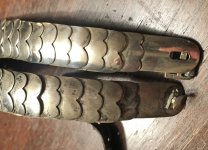So here's what I ended up doing. I rummaged around and found an old dremel-like tool, but discovered it was broken so decided I wasn't going to go that route. I tried using a vinegar solution but the tarnish wouldn't budge. I decided to test chemical treatment with Tarn-x and that worked well so I applied that to the whole set and cleaned the scales that way. To be a little more precise, I gathered a pile of Q-tips and had a small bowl of Tarn-x, a bowl of soapy water and a bowl of clear water. I dipped Q-tips in the chemical and carefully removed the black tarnish one scale at a time. After removing the tarnish I washed the area with a soapy Q-tip and then rinsed with a wet Q-tip (small amounts of liquid at each step). The careful washing is required because otherwise the Tarn-x can cause spotting. Following this I dried the area with a soft clean dry rag. Removing the tarnish required a lot of rubbing and many Q-tips. Once the tarnish was removed I polished the scales with silver polish. Again, one scale at a time removing excess polish with a wet Q-tip and drying with a clean dry rag. The process took over two hours, but the results were satisfying.
I wouldn't try on gilt chinscales, but it might work on tombak or similar surfaces. I also wouldn't try this on a fragile pair of chinscales because a lot of manipulation is required.
In the photo "before" on the bottom, "after" on the top.
Mark D.

